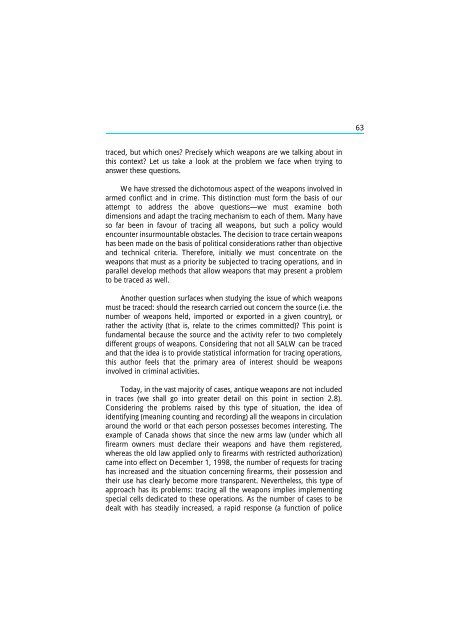The Scope and Implications of a Tracing Mechanism for Small Arms ...
The Scope and Implications of a Tracing Mechanism for Small Arms ...
The Scope and Implications of a Tracing Mechanism for Small Arms ...
Create successful ePaper yourself
Turn your PDF publications into a flip-book with our unique Google optimized e-Paper software.
63<br />
traced, but which ones? Precisely which weapons are we talking about in<br />
this context? Let us take a look at the problem we face when trying to<br />
answer these questions.<br />
We have stressed the dichotomous aspect <strong>of</strong> the weapons involved in<br />
armed conflict <strong>and</strong> in crime. This distinction must <strong>for</strong>m the basis <strong>of</strong> our<br />
attempt to address the above questions—we must examine both<br />
dimensions <strong>and</strong> adapt the tracing mechanism to each <strong>of</strong> them. Many have<br />
so far been in favour <strong>of</strong> tracing all weapons, but such a policy would<br />
encounter insurmountable obstacles. <strong>The</strong> decision to trace certain weapons<br />
has been made on the basis <strong>of</strong> political considerations rather than objective<br />
<strong>and</strong> technical criteria. <strong>The</strong>re<strong>for</strong>e, initially we must concentrate on the<br />
weapons that must as a priority be subjected to tracing operations, <strong>and</strong> in<br />
parallel develop methods that allow weapons that may present a problem<br />
to be traced as well.<br />
Another question surfaces when studying the issue <strong>of</strong> which weapons<br />
must be traced: should the research carried out concern the source (i.e. the<br />
number <strong>of</strong> weapons held, imported or exported in a given country), or<br />
rather the activity (that is, relate to the crimes committed)? This point is<br />
fundamental because the source <strong>and</strong> the activity refer to two completely<br />
different groups <strong>of</strong> weapons. Considering that not all SALW can be traced<br />
<strong>and</strong> that the idea is to provide statistical in<strong>for</strong>mation <strong>for</strong> tracing operations,<br />
this author feels that the primary area <strong>of</strong> interest should be weapons<br />
involved in criminal activities.<br />
Today, in the vast majority <strong>of</strong> cases, antique weapons are not included<br />
in traces (we shall go into greater detail on this point in section 2.8).<br />
Considering the problems raised by this type <strong>of</strong> situation, the idea <strong>of</strong><br />
identifying (meaning counting <strong>and</strong> recording) all the weapons in circulation<br />
around the world or that each person possesses becomes interesting. <strong>The</strong><br />
example <strong>of</strong> Canada shows that since the new arms law (under which all<br />
firearm owners must declare their weapons <strong>and</strong> have them registered,<br />
whereas the old law applied only to firearms with restricted authorization)<br />
came into effect on December 1, 1998, the number <strong>of</strong> requests <strong>for</strong> tracing<br />
has increased <strong>and</strong> the situation concerning firearms, their possession <strong>and</strong><br />
their use has clearly become more transparent. Nevertheless, this type <strong>of</strong><br />
approach has its problems: tracing all the weapons implies implementing<br />
special cells dedicated to these operations. As the number <strong>of</strong> cases to be<br />
dealt with has steadily increased, a rapid response (a function <strong>of</strong> police
















